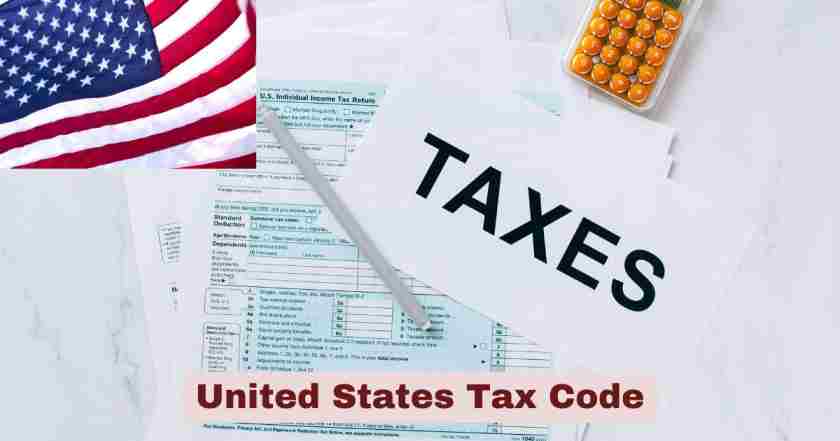The United States tax code represents one of the most intricate legal frameworks in American law, governing how individuals, businesses, and organizations contribute to federal revenue.
| Overview Element | Description |
|---|---|
| Primary Purpose | Federal tax law framework |
| Scope | Individual, business, and organizational taxation |
| Complexity Level | Highly complex legal document |
| Impact | Affects all American taxpayers |
This comprehensive guide explores every aspect of the US tax code, from its fundamental structure to specific provisions that impact millions of taxpayers annually.
1. US Tax Code – Overview
| Fundamental Aspect | Details |
|---|---|
| Official Name | Internal Revenue Code (IRC) |
| Legal Reference | Title 26, United States Code |
| Total Word Count | Over 2.4 million words |
| Number of Sections | Approximately 9,834 sections |
| Last Major Reform | Tax Cuts and Jobs Act (2017) |
| Administrative Agency | Internal Revenue Service (IRS) |
The US tax code, formally known as the Internal Revenue Code (IRC), serves as the foundation of America’s federal tax system. Established in 1913 with the ratification of the 16th Amendment, this complex legal document has evolved into a massive compilation of tax laws, regulations, and procedures that dictate how Americans pay taxes.
The current tax code consists of over 2.4 million words and spans thousands of pages, making it one of the most comprehensive legal documents in existence. The code is organized into subtitles, chapters, subchapters, parts, and sections, each addressing specific aspects of taxation from income tax to estate planning.
Title 26 of the United States Code contains the complete Internal Revenue Code, which encompasses all federal tax laws. This systematic organization allows tax professionals, attorneys, and taxpayers to navigate the complex web of tax regulations that govern everything from individual income tax returns to corporate tax obligations.
The tax code undergoes frequent modifications through congressional legislation, with major overhauls occurring approximately every decade. The most recent significant change was the Tax Cuts and Jobs Act of 2017, which altered numerous provisions affecting both individual and business taxation.
2. Stats & Facts About US Tax Code
| Key Statistic | Value |
|---|---|
| Pages in 1913 | 400 pages |
| Current Page Count | Over 75,000 pages |
| Annual Compliance Hours | 6.6 billion hours |
| Average Individual Preparation Time | 13 hours |
| Professional Preparation Rate | 56% of returns |
| Annual Returns Processed | 150+ million |
| Tax Prep Industry Revenue | $9+ billion |
The complexity of the US tax code has grown exponentially since its inception, with the number of pages increasing from 400 in 1913 to over 75,000 pages today. This dramatic expansion reflects the evolving nature of American society, business practices, and economic policies over the past century.
Americans spend approximately 6.6 billion hours annually preparing their tax returns, according to the Treasury Inspector General for Tax Administration. This staggering figure represents roughly 3.2 million full-time equivalent workers dedicated solely to tax compliance activities.
The average American taxpayer requires 13 hours to complete their federal tax return, including time spent record-keeping, tax planning, form completion, and submission. For businesses, this time investment increases dramatically, with small businesses averaging 40 hours annually for tax compliance.
Professional tax preparers handle approximately 56% of all individual tax returns filed, highlighting the complexity that drives millions of Americans to seek professional assistance. The tax preparation industry generates over $9 billion in annual revenue, employing hundreds of thousands of tax professionals.
The IRS processes more than 150 million individual tax returns annually, along with millions of business returns, amended returns, and other tax-related documents. This massive processing operation requires sophisticated technology systems and thousands of employees working year-round.
3. US Tax Code – Complete List
| Subtitle/Chapter/Section | Description | Section Range |
|---|---|---|
| SUBTITLE A – INCOME TAXES | ||
| Chapter 1 | Normal Taxes and Surtaxes | Sections 1-1564 |
| Chapter 2 | Tax on Self-Employment Income | Sections 1401-1403 |
| Chapter 2A | Unearned Income Medicare Contribution | Section 1411 |
| Chapter 3 | Withholding of Tax on Nonresident Aliens | Sections 1441-1464 |
| Chapter 4 | Taxes to Enforce Reporting on Certain Foreign Accounts | Sections 1471-1474 |
| Chapter 5 | Tax on Transfers to Avoid Income Tax | Section 1491-1494 |
| Chapter 6 | Consolidated Returns | Sections 1501-1505 |
| SUBTITLE B – ESTATE AND GIFT TAXES | ||
| Chapter 11 | Estate Tax | Sections 2001-2210 |
| Chapter 12 | Gift Tax | Sections 2501-2524 |
| Chapter 13 | Tax on Generation-Skipping Transfers | Sections 2601-2664 |
| Chapter 14 | Special Valuation Rules | Sections 2701-2704 |
| Chapter 15 | Gifts and Bequests from Expatriates | Section 2801 |
| SUBTITLE C – EMPLOYMENT TAXES | ||
| Chapter 21 | Federal Insurance Contributions Act | Sections 3101-3128 |
| Chapter 22 | Railroad Retirement Tax Act | Sections 3201-3241 |
| Chapter 23 | Federal Unemployment Tax Act | Sections 3301-3311 |
| Chapter 23A | Railroad Unemployment Repayment Tax | Section 3321 |
| Chapter 24 | Collection of Income Tax at Source | Sections 3401-3406 |
| Chapter 25 | General Provisions Relating to Employment Taxes | Section 3501-3510 |
| SUBTITLE D – MISCELLANEOUS EXCISE TAXES | ||
| Chapter 31 | Retail Excise Taxes | Sections 4001-4053 |
| Chapter 32 | Manufacturers Excise Taxes | Sections 4061-4132 |
| Chapter 33 | Facilities and Services | Sections 4231-4286 |
| Chapter 34 | Policies Issued by Foreign Insurers | Section 4371-4374 |
| Chapter 35 | Taxes on Wagering | Sections 4401-4424 |
| Chapter 36 | Certain Other Excise Taxes | Sections 4461-4483 |
| Chapter 37 | Sugar | Section 4501 |
| Chapter 38 | Environmental Taxes | Sections 4611-4682 |
| Chapter 39 | Registration-Required Obligations | Section 4701 |
| Chapter 40 | General Provisions Relating to Occupational Taxes | Sections 4901-4907 |
| Chapter 41 | Public Charities | Section 4911-4912 |
| Chapter 42 | Private Foundations and Certain Other Tax-Exempt Organizations | Sections 4940-4948 |
| Chapter 43 | Qualified Pension Plans | Sections 4971-4980I |
| Chapter 44 | Qualified Investment Entities | Section 4981-4982 |
| SUBTITLE E – ALCOHOL, TOBACCO, AND CERTAIN OTHER EXCISE TAXES | ||
| Chapter 51 | Distilled Spirits, Wines, and Beer | Sections 5001-5692 |
| Chapter 52 | Tobacco Products and Cigarette Papers and Tubes | Sections 5701-5763 |
| Chapter 53 | Machine Guns, Destructive Devices, and Certain Other Firearms | Sections 5801-5872 |
| SUBTITLE F – PROCEDURE AND ADMINISTRATION | ||
| Chapter 61 | Information and Returns | Sections 6001-6111 |
| Chapter 62 | Time and Place for Paying Tax | Sections 6151-6167 |
| Chapter 63 | Assessment | Sections 6201-6241 |
| Chapter 64 | Collection | Sections 6301-6344 |
| Chapter 65 | Abatements, Credits, and Refunds | Sections 6401-6432 |
| Chapter 66 | Limitations | Sections 6501-6533 |
| Chapter 67 | Interest | Sections 6601-6622 |
| Chapter 68 | Additions to Tax, Additional Amounts, and Assessable Penalties | Sections 6651-6751 |
| Chapter 69 | General Provisions Relating to Stamps | Section 6801-6808 |
| Chapter 70 | Jeopardy, Receiverships, Etc. | Sections 6851-6873 |
| Chapter 71 | Transferees and Fiduciaries | Sections 6901-6905 |
| Chapter 72 | Licensing and Registration | Sections 7001-7012 |
| Chapter 73 | Bonds | Sections 7101-7108 |
| Chapter 74 | Closing Agreements and Compromises | Sections 7121-7124 |
| Chapter 75 | Crimes, Other Offenses, and Forfeitures | Sections 7201-7345 |
| Chapter 76 | Judicial Proceedings | Sections 7401-7493 |
| Chapter 77 | Miscellaneous Provisions | Sections 7501-7528 |
| Chapter 78 | Discovery of Liability and Enforcement of Title | Sections 7601-7655 |
| Chapter 79 | Definitions | Section 7701 |
| Chapter 80 | General Rules | Sections 7801-7874 |
| SUBTITLE G – JOINT COMMITTEE ON TAXATION | ||
| Chapter 91 | Organization and Membership of Joint Committee | Sections 8001-8005 |
| Chapter 92 | Powers and Duties of Joint Committee | Sections 8021-8023 |
| SUBTITLE H – FINANCING OF PRESIDENTIAL ELECTION CAMPAIGNS | ||
| Chapter 95 | Presidential Election Campaign Fund | Sections 9001-9013 |
| Chapter 96 | Presidential Primary Matching Payment Account | Sections 9031-9042 |
| SUBTITLE I – TRUST FUND CODE | ||
| Chapter 98 | Trust Fund Code | Sections 9501-9602 |
| SUBTITLE J – COAL INDUSTRY HEALTH BENEFITS | ||
| Chapter 99 | Coal Industry Health Benefits | Sections 9701-9722 |
| SUBTITLE K – GROUP HEALTH PLAN REQUIREMENTS | ||
| Chapter 100 | Group Health Plan Requirements | Sections 9801-9834 |
The US tax code is systematically organized into eleven subtitles, each covering distinct areas of federal taxation. This hierarchical structure allows for logical organization of the thousands of provisions that comprise America’s tax system.
SUBTITLE A – INCOME TAXES
Subtitle A establishes the framework for federal income taxation in the United States. It covers taxes on income earned by individuals, corporations, estates, and trusts. This section includes rules on tax rates, deductions, credits, capital gains, and international taxation. It’s the largest and most commonly used part of the Internal Revenue Code, forming the basis for calculating annual income taxes.
SUBTITLE B – ESTATE AND GIFT TAXES
This subtitle governs the federal taxation of wealth transfers during life and after death. It includes the estate tax, which applies to the transfer of a deceased person’s assets, and the gift tax, which applies to significant transfers made during a person’s lifetime. It also includes the generation-skipping transfer tax, designed to prevent tax avoidance across multiple generations.
SUBTITLE C – EMPLOYMENT TAXES
Subtitle C outlines the employment-related tax obligations of employers and employees. It includes Social Security and Medicare taxes (FICA), self-employment tax (SECA), and federal unemployment taxes (FUTA). These taxes help fund essential government programs like retirement benefits and unemployment insurance. This section also details the rules for tax withholding, depositing, and reporting employment taxes to the IRS.
SUBTITLE D – MISCELLANEOUS EXCISE TAXES
Covers excise taxes applied to various specific goods, services, and activities such as fuel, air travel, heavy vehicles, and medical devices. These taxes are not based on income but are typically included in the price of products or services. Subtitle D also outlines compliance requirements for businesses responsible for collecting and remitting these taxes to the federal government.
SUBTITLE E – ALCOHOL, TOBACCO, AND CERTAIN OTHER EXCISE TAXES
This subtitle governs federal excise taxes on alcohol, tobacco products, and firearms. It includes licensing, packaging, labeling, and reporting requirements enforced by the Alcohol and Tobacco Tax and Trade Bureau (TTB). These taxes are intended both to generate revenue and discourage the consumption or misuse of regulated substances. It’s a critical part of tax law for manufacturers and distributors.
SUBTITLE F – PROCEDURE AND ADMINISTRATION
Subtitle F defines how the IRS administers and enforces the tax laws. It includes rules on how taxes are assessed, collected, and disputed. It also covers audit procedures, interest, penalties, appeals, statute of limitations, and criminal tax enforcement. This section ensures taxpayer rights are protected while allowing the IRS to enforce compliance and maintain the integrity of the tax system.
SUBTITLE G – JOINT COMMITTEE ON TAXATION
This subtitle outlines the creation and responsibilities of the Joint Committee on Taxation (JCT), a nonpartisan congressional committee. The JCT assists Congress by analyzing tax legislation, estimating revenue effects, and reviewing large tax refunds or credits. It plays a vital role in shaping U.S. tax policy and ensuring tax laws are fiscally sound and effectively implemented.
SUBTITLE H – FINANCING OF PRESIDENTIAL ELECTION CAMPAIGNS
Subtitle H establishes a voluntary system for public funding of presidential elections. It includes provisions for taxpayer contributions through a checkbox on tax returns, as well as matching funds for qualifying candidates. The goal is to reduce dependence on private donations, promote transparency, and provide an even playing field in presidential campaign financing.
SUBTITLE I – TRUST FUND CODE
This subtitle governs the establishment and management of federal trust funds that collect and allocate revenue for specific government programs. Examples include the Highway Trust Fund and the Airport and Airway Trust Fund. It outlines how revenue from excise taxes is directed into these funds, ensuring dedicated funding for infrastructure and other long-term government initiatives.
SUBTITLE J – COAL INDUSTRY HEALTH BENEFITS
Subtitle J establishes funding mechanisms to provide health care benefits to retired coal miners and their dependents. It supports programs administered by the United Mine Workers of America (UMWA) and includes provisions for premium payments, employer contributions, and federal subsidies. This subtitle ensures that long-serving miners receive the promised healthcare benefits even after industry decline or company bankruptcies.
SUBTITLE K – GROUP HEALTH PLAN REQUIREMENTS
This subtitle governs federal regulations applicable to group health insurance plans offered by employers. It includes mandates from HIPAA, the ACA, and other health legislation. Key provisions cover pre-existing condition exclusions, continuation of coverage (COBRA), and nondiscrimination rules. The aim is to protect employees’ rights and ensure accessible, fair, and portable group health coverage across employment changes
4. US Code 26
| US Code 26 Element | Details |
|---|---|
| Official Title | Internal Revenue Code |
| Legal Authority | Title 26, United States Code |
| Total Chapters | 79 chapters |
| Primary Sections | Over 9,800 sections |
| Update Frequency | Annual with periodic revisions |
| Enforcement Agency | Internal Revenue Service |
| Court Jurisdiction | U.S. Tax Court, Federal Courts |
US Code 26 represents the complete codification of federal tax law within the United States legal system. This title of the United States Code contains the entire Internal Revenue Code, serving as the authoritative source for all federal tax statutes and regulations.
The designation “26” refers to the specific title number within the broader United States Code, which organizes all federal laws into 54 titles covering different subject areas. Title 26 exclusively addresses taxation matters, making it the primary reference for tax professionals, attorneys, and government officials.
Congress regularly updates US Code 26 through new legislation, with changes typically taking effect at the beginning of each calendar year or tax year. These modifications can range from minor technical corrections to comprehensive tax reform legislation that affects millions of taxpayers.
The structure of US Code 26 mirrors the Internal Revenue Code organization, with identical section numbers, subsections, and paragraph designations. This parallel structure ensures consistency between the official United States Code and the practical tax code used by practitioners.
5. US Tax Code 179
| Section 179 Details | Current Information |
|---|---|
| 2024 Deduction Limit | $1,180,000 |
| Phase-out Threshold | $2,950,000 |
| Qualifying Property | Business equipment, machinery, vehicles |
| Carryforward Period | Unlimited |
| Election Requirement | Annual election on tax return |
| Recapture Rules | Apply if business use drops below 50% |
Section 179 of the US tax code provides immediate expensing opportunities for qualifying business equipment and property purchases. This powerful tax provision allows businesses to deduct the full cost of eligible assets in the year of purchase, rather than depreciating the cost over several years.
The Section 179 deduction limit for 2024 is $1,180,000, with a phase-out threshold beginning at $2,950,000 in total equipment purchases. This means businesses can immediately expense up to the limit amount, but the deduction phases out dollar-for-dollar once total purchases exceed the threshold.
Qualifying property under Section 179 includes tangible personal property used in business, such as machinery, equipment, computers, software, furniture, and certain vehicles. The property must be purchased and placed in service during the tax year to qualify for the deduction.
Businesses must actively elect Section 179 treatment on their tax returns and cannot exceed their taxable income from active business operations. Any unused deduction can be carried forward to future tax years without limitation, providing flexibility for businesses with varying income levels.
The Section 179 deduction includes important recapture provisions that apply if the business use of property drops below 50% in subsequent years. Taxpayers must recapture previously claimed deductions and pay additional taxes plus interest on the recaptured amounts.
6. US Tax Code 501(c)(3)
| 501(c)(3) Characteristics | Requirements |
|---|---|
| Tax-exempt Status | Federal and most state taxes |
| Donation Deductibility | Contributions are tax-deductible |
| Purpose Limitations | Charitable, religious, educational, scientific |
| Political Activity | Prohibited from candidate endorsement |
| Private Benefit | Must serve public interest |
| Annual Filing | Form 990 series required |
Section 501(c)(3) of the US tax code establishes the framework for charitable organizations to achieve tax-exempt status. This provision represents one of the most important sections for nonprofit organizations, religious institutions, educational facilities, and charitable foundations seeking federal tax exemption.
Organizations qualifying under 501(c)(3) must operate exclusively for charitable, religious, educational, scientific, or literary purposes. The “exclusively” requirement means that exempt purposes must be the organization’s primary focus, though some incidental non-exempt activities may be permissible.
Contributions to 501(c)(3) organizations are generally tax-deductible for donors, making this status highly valuable for fundraising efforts. Donors can typically deduct contributions up to 50% of their adjusted gross income, with higher limits available for certain types of contributions.
Political campaign intervention is strictly prohibited for 501(c)(3) organizations, meaning they cannot endorse candidates, contribute to political campaigns, or engage in activities that support or oppose specific candidates for public office. However, limited lobbying activities may be permissible under certain circumstances.
The application process for 501(c)(3) status involves filing Form 1023 or Form 1023-EZ with the IRS, along with supporting documentation demonstrating the organization’s exempt purposes and operational structure. The IRS reviews applications to ensure compliance with all statutory requirements.
7. IRS Code 1445
| IRS Code 1445 Elements | Details |
|---|---|
| Purpose | Withholding on foreign person dispositions |
| Withholding Rate | Generally 15% of gross proceeds |
| Property Types | U.S. real property interests |
| Transferee Responsibility | Buyer must withhold and remit |
| Exemption Certificates | Available for qualifying transactions |
| Reporting Form | Form 8288 and 8288-A |
IRS Code 1445 establishes withholding requirements for dispositions of U.S. real property interests by foreign persons. This provision ensures tax collection on gains from real estate transactions involving non-resident aliens and foreign entities, addressing potential collection challenges when sellers are outside U.S. jurisdiction.
The general withholding rate under Section 1445 is 15% of the gross sales price, though lower rates may apply for certain residential transactions or when the transferor obtains a withholding certificate from the IRS. The buyer (transferee) bears responsibility for withholding the required amount and remitting it to the IRS.
Qualifying property includes direct ownership of real estate and interests in entities that hold U.S. real property, such as partnerships, corporations, or trusts with substantial real estate holdings. The definition encompasses both commercial and residential properties located within the United States.
Withholding certificates allow reduced or eliminated withholding when the transferor demonstrates that no tax is due or that a lower amount should be withheld. The IRS evaluates certificate applications based on the transferor’s tax situation and potential gain or loss from the transaction.
Compliance requires filing Form 8288 and providing Form 8288-A to the transferor within 20 days of the transfer. These forms document the withholding amount and provide the foreign person with credit for taxes withheld, which can be applied against their U.S. tax liability.
8. US Treasury 310
| US Treasury 310 Details | Information |
|---|---|
| Purpose | Electronic payment identifier |
| Payment Types | Tax refunds, benefits, government payments |
| Processing System | Automated Clearing House (ACH) |
| Bank Statement Description | “US Treasury 310” |
| Verification Method | IRS.gov “Where’s My Refund” tool |
| Direct Deposit Timeline | 21 days for e-filed returns |
US Treasury 310 serves as the identifying code for electronic payments made by the United States Treasury, appearing on bank statements when taxpayers receive direct deposits from federal agencies. This code most commonly appears in connection with tax refunds, stimulus payments, and other government benefits.
The “310” designation specifically identifies the Treasury Department as the originating agency for Automated Clearing House (ACH) transactions. Recipients see this code on their bank statements along with descriptive text indicating the nature of the payment, such as “TAX REF” for tax refunds.
Tax refunds represent the most frequent use of the Treasury 310 code, with millions of Americans receiving their refunds via direct deposit each tax season. The IRS processes refunds more quickly through direct deposit compared to paper checks, typically within 21 days for electronically filed returns.
Verification of Treasury 310 payments can be accomplished through official IRS tools, including the “Where’s My Refund” online system and the IRS2Go mobile application. These tools allow taxpayers to track their refund status and confirm legitimate payments from the Treasury.
Other government payments using the Treasury 310 code include stimulus payments, Social Security benefits, and federal employee payroll deposits. The consistent use of this identifier helps recipients recognize legitimate government payments and distinguish them from potential fraudulent transactions.
9. Tax Code Compliance and Enforcement
| Enforcement Element | Details |
|---|---|
| Audit Selection Rate | Approximately 0.4% of returns |
| Penalty Types | Failure to file, pay, accuracy-related |
| Interest Rates | Quarterly adjustments based on federal rates |
| Collection Procedures | Liens, levies, asset seizure |
| Taxpayer Rights | Appeals process, representation rights |
| Statute of Limitations | Generally 3 years for assessments |
The IRS employs sophisticated computer algorithms to identify tax returns with the highest audit potential, focusing resources on returns with unusual patterns, significant discrepancies, or characteristics historically associated with tax compliance issues. The overall audit rate remains relatively low at approximately 0.4% of all filed returns.
Civil penalties for tax code violations include failure-to-file penalties of 5% per month up to 25% of unpaid taxes, failure-to-pay penalties of 0.5% per month, and accuracy-related penalties of 20% for substantial understatements of tax liability. These penalties can accumulate quickly and significantly increase total tax obligations.
Interest accrues on unpaid taxes and penalties from the original due date of the return, with rates adjusted quarterly based on federal short-term interest rates plus three percentage points. This compounding interest can substantially increase tax debts over time, making prompt payment advantageous.
Collection enforcement tools available to the IRS include federal tax liens, bank account levies, wage garnishments, and asset seizures. These powerful collection mechanisms can significantly impact taxpayers’ financial situations and credit ratings, emphasizing the importance of addressing tax obligations promptly.
10. Recent Tax Code Changes and Future Outlook
| Recent Changes | Impact |
|---|---|
| Tax Cuts and Jobs Act (2017) | Reduced individual and corporate rates |
| CARES Act (2020) | Enhanced deductions, stimulus provisions |
| American Rescue Plan (2021) | Expanded child tax credit, earned income credit |
| Inflation Reduction Act (2022) | Clean energy incentives, IRS funding |
| Secure Act 2.0 (2022) | Retirement plan enhancements |
| Current Proposals | Various congressional initiatives |
The Tax Cuts and Jobs Act of 2017 represented the most significant tax reform in decades, reducing individual tax rates, nearly doubling the standard deduction, and lowering the corporate tax rate from 35% to 21%. Many individual provisions are scheduled to sunset after 2025, creating potential future changes.
COVID-19 pandemic legislation introduced numerous temporary tax provisions, including enhanced unemployment benefits, stimulus payments, expanded child tax credits, and business support measures. These provisions demonstrated the tax code’s role in economic policy beyond revenue collection.
The Inflation Reduction Act of 2022 focused heavily on clean energy tax incentives, extending and expanding credits for renewable energy installations, electric vehicles, and energy-efficient home improvements. The legislation also provided significant funding increases for IRS enforcement activities.
Future tax policy discussions center around expiring provisions from the Tax Cuts and Jobs Act, with debates over extending, modifying, or allowing various provisions to sunset. Additional proposals address wealth taxes, carried interest treatment, and international tax coordination efforts.
Technological advances continue to influence tax administration, with the IRS investing in modernized systems, enhanced data analytics, and improved taxpayer services. These improvements aim to reduce processing times, improve accuracy, and enhance the overall taxpayer experience while maintaining robust compliance enforcement.
Disclaimer: The data research report we present here is based on information found from various sources. We are not liable for any financial loss, errors, or damages of any kind that may result from the use of the information herein. We acknowledge that though we try to report accurately, we cannot verify the absolute facts of everything that has been represented.







